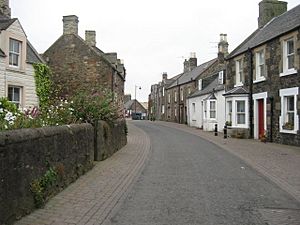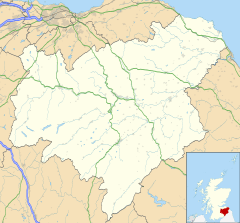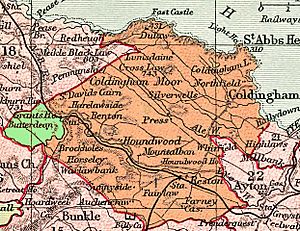Coldingham facts for kids
Quick facts for kids Coldingham |
|
|---|---|
 Coldingham High Street |
|
| Population | 500 (2020) |
| OS grid reference | NT905665 |
| Council area | |
| Lieutenancy area | |
| Country | Scotland |
| Sovereign state | United Kingdom |
| Post town | EYEMOUTH |
| Postcode district | TD14 |
| Dialling code | 01890 |
| Police | Lothian and Borders |
| Fire | Lothian and Borders |
| Ambulance | Scottish |
| EU Parliament | Scotland |
| UK Parliament |
|
| Scottish Parliament | |
Coldingham is a lovely village and parish located in Berwickshire, which is part of the Scottish Borders area in Scotland. It's not far from the beautiful Coldingham Bay and about three miles northeast of the fishing village called Eyemouth.
Contents
Exploring Coldingham Parish
A parish is like a local area or district. Coldingham Parish is quite large, being the second-biggest civil parish in Berwickshire. It stretches from the North Sea in the northwest to other nearby parishes like Eyemouth, Ayton, Chirnside, Bunkle, Abbey St Bathans, and Cockburnspath.
Villages in Coldingham Parish
Besides the main village of Coldingham, this parish includes several other smaller villages:
- St Abbs (which used to be called Coldingham Shore)
- Reston
- Auchencrow
- Grantshouse
These villages are grouped into different Community Council areas. Coldingham Parish was part of the Berwickshire District from 1975 to 1996.
Coldingham Priory's Influence
Long ago, before the Scottish Reformation (a big change in religion around 1560), a large area called Coldinghamshire was connected to Coldingham Priory. This priory was a type of monastery. By the 1400s, local government started to become more important, even with the Church's agreement.
For example, in 1406, a powerful person named Archibald, the Earl of Douglas, was in charge of the Priory's land. In 1414, the leaders of the priory officially made him the "sovereign bailie" (a kind of governor) of the priory and its lands. This area, known as the Barony of Coldingham, included Eyemouth and other places. It continued to be an important local area for many years.
Changes to the Parish Church
Because Coldingham Parish was so big, an extra church was built in 1794 for the western part of the area. Later, in 1816, a new main road (now the A1) made it easier to travel between Grantshouse and Reston. So, in 1836, a new church was built halfway between these villages, at a place called Houndwood.
Houndwood became its own church parish in 1851. Today, this parish is connected to Ayton, and people go to churches in Reston and Grantshouse. The old Houndwood church building was turned into a crematorium in 2015.
Local Government Changes
In 1845, a "Parochial Board" was set up to help people in need. Then, in 1894, the Coldingham Parish Council was created. This council helped the poor and managed public services, like improving the Houndwood cemetery in 1901.
Civil parishes in Scotland stopped being units of local government in 1929. However, they are still used for things like counting populations in a census. In 1891, a small part of Oldhamstocks parish called Butterdean was moved to Coldingham parish.
Today, the civil parish of Coldingham covers about 25,379 acres and had a population of 1,919 people in 2011.
Coldingham Village Life
The village of Coldingham itself is home to about 563 people (as of 2011).
Just a short distance away is Coldingham Bay. This bay has a beautiful, sandy beach that's very popular with surfers. You'll also see rows of colourful beach huts there!
Coldingham's Ancient Monastery
Coldingham has a very long history, especially with its monastery.
The First Monastery
There was a very important monastery here as early as AD 660. Records show that Etheldreda, a queen, became a nun at this monastery. It was managed by Æbbe the Elder, who was the aunt of the queen's husband.
A famous historian named Bede called it "the Monastery of Virgins." Sadly, in 679, the monastery burned down. It was rebuilt, but then in 870, it was destroyed again by Viking raiders.
The Priory and Its History
After the second fire, the monastery wasn't rebuilt for a long time. Then, in 1098, King Edgar founded the Coldingham Priory in honour of St. Cuthbert of Lindisfarne. This priory became the main centre for the Barony of Coldingham, and the prior (the head of the priory) became the local lord.
The priory continued as a religious place until 1560. At that time, during the Scottish Reformation, parts of it were destroyed. However, some parts of it continued to be used for religious activities until 1650. During a conflict with Oliver Cromwell, the priory was used as a fort. After a two-day siege, the main tower was so badly damaged by cannons that the defenders had to give up. This great tower finally fell down around 1777.
Today, about 40% of the original priory church was rebuilt in 1855. It is now used as the local parish church and is the most famous building in Coldingham.
Images for kids








